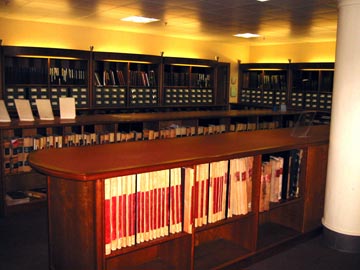 Griffith’s Valuation House Books are the notebooks that were used by valuators to record information on the majority of the buildings of Ireland, be it dwelling house, out-office or even lavatory in order to place a rateable value on the building and these records formed part of the information-gathering process required for the completion of the Primary Valuation of Ireland.
Griffith’s Valuation House Books are the notebooks that were used by valuators to record information on the majority of the buildings of Ireland, be it dwelling house, out-office or even lavatory in order to place a rateable value on the building and these records formed part of the information-gathering process required for the completion of the Primary Valuation of Ireland.
The purpose of the Primary Valuation of Ireland, a survey that was conducted under the direction of Richard Griffith, was to assess the amount of tax every rateable occupier should contribute towards the support of the poor and destitute in their parish. The Primary Valuation was completed and published between 1847 and 1864. Dublin City and County were the first areas of Ireland to have their valuation completed. The Primary Valuation of Ireland recorded the townland address, the name of each rated occupier, the names of the immediate lessor (the landlord’s name), a brief description of the landholding, the number of acres of land in each holding, the value of buildings and land for taxation purposes, together with the overall valuation of each holding.
The compilation of the House Books was part of the information-gathering process required for the completion of the Primary Land Valuation of Ireland. In order to assess the amount of tax rated occupiers would contribute towards the upkeep of the poor and destitute a rateable value had to be placed on their buildings and land.
The information contained in the Griffith’s Valuation House Books , which were completed shortly before the compilation and publication of the Primary Valuation of Ireland, provide the first detailed information on the nature of the houses some people occupied. ‘Some people’, because the surveyors employed to conduct the Primary Valuation of Ireland only carried out minute surveys on property valued at more than £10 per annum. However, in reality valuators recorded some detail on almost every house and tenement they visited.
The House Books typically recorded the occupiers’ names, sometimes the landowner’s name and the measurements of any buildings included in each individual holding, including out-offices such as barns and stables and even out-door lavatories. In the case of larger houses returns, or additions to the main dwelling, were also individually measured. The Griffith’s Valuation House Books usually include a quality letter for properties, which provided an indication of the physical condition as well as an estimation of the building’s age.
The House Books generally date from just before the publication of Griffith’s Valuation of Ireland, although in some instances they can pre-date Griffith’s by as much as five years. For some parishes more than one House Book might survive. This is usually an indication that one or more of the rated occupiers challenged the provisional rateable value placed on their premises.
For genealogical purposes the use of the House Books are manifold: pre-dating Griffith’s, they can identify previous occupants as well as providing a clear sense of the type of house an ancestor once occupied.
The following is a description of the quality letters regarding solidity, age and repair placed on property in the House Books:
New or Nearly New Houses
A+ Built or ornamented with cut stone, and of superior solidity and finish.
A. Very substantial building and finish, without cut stone ornament.
A- Ordinary Building and finish or either of the above when built 20 or 25 years.
Houses of Medium Age (25+?).
B+ Medium but not new, but in sound order and in good repair.
B. Medium, slightly decayed by age, but in good repair.
B- Medium, deteriorated by age, and not in perfect repair.
Old Houses (Older than 25 years).
C+ Old but in good repair.
C Old and out of repair.
C- Old and dilapidated, scarcely habitable.
Numbers for Dwellings
1. Includes all slated dwelling houses, built with stone or brick and lime and mortar.
2. Thatches houses built with stone or lime and mortar.
3. Thatched houses having stone walls, with mud or puddle mortar; dry stone walls pointed, or mud walls of the best kind.
4. Basement stories of slated houses used as dwellings.
Table for Offices
1. Includes all slated offices built with stone, or brick walls with good lime mortar.
2. Thatched offices built with stone or brick walls and lime mortar.
3. Thatched offices having stone walls with mud or puddle mortar, dry stone walls pointed, or good mud walls.
4. Thatched offices built with stone walls.
The survival of House Books varies from county to county. Those with the poorest survival rate include Clare, Kilkenny, Leitrim, Longford, Monaghan, Roscommon, Sligo and Westmeath. The House Books held in the National Archives of Ireland collection can are now free to access on the National Archive’s Genealogy Website. Those for the six counties of Northern Ireland at the Public Records Office of Northern Ireland.
